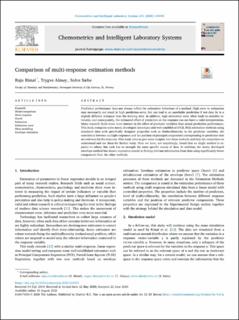| dc.contributor.author | Rimal, Raju | |
| dc.contributor.author | Almøy, Trygve | |
| dc.contributor.author | Sæbø, Solve | |
| dc.date.accessioned | 2020-11-30T14:28:24Z | |
| dc.date.available | 2020-11-30T14:28:24Z | |
| dc.date.created | 2020-09-08T16:14:55Z | |
| dc.date.issued | 2020 | |
| dc.identifier.citation | Chemometrics and Intelligent Laboratory Systems, Volume 205, 15 October 2020, 104093 | en_US |
| dc.identifier.issn | 0169-7439 | |
| dc.identifier.uri | https://hdl.handle.net/11250/2690302 | |
| dc.description.abstract | Prediction performance does not always reflect the estimation behaviour of a method. High error in estimation may necessarily not result in high prediction error, but can lead to an unreliable prediction if test data lie in a slightly different subspace than the training data. In addition, high estimation error often leads to unstable estimates, and consequently, the estimated effect of predictors on the response can not have a valid interpretation. Many research fields show more interest in the effect of predictor variables than actual prediction performance. This study compares some newly-developed (envelope) and well-established (PCR, PLS) estimation methods using simulated data with specifically designed properties such as Multicollinearity in the predictor variables, the correlation between multiple responses and the position of principal components corresponding to predictors that are relevant for the response. This study aims to give some insights into these methods and help the researchers to understand and use them for further study. Here we have, not surprisingly, found that no single method is superior to others, but each has its strength for some specific nature of data. In addition, the newly developed envelope method has shown impressive results in finding relevant information from data using significantly fewer components than the other methods. | en_US |
| dc.language.iso | eng | en_US |
| dc.rights | Attribution-NonCommercial-NoDerivatives 4.0 Internasjonal | * |
| dc.rights.uri | http://creativecommons.org/licenses/by-nc-nd/4.0/deed.no | * |
| dc.title | Comparison of multi-response estimation methods | en_US |
| dc.type | Peer reviewed | en_US |
| dc.type | Journal article | en_US |
| dc.description.version | publishedVersion | en_US |
| dc.source.volume | 205 | en_US |
| dc.source.journal | Chemometrics and Intelligent Laboratory Systems | en_US |
| dc.identifier.doi | https://doi.org/10.1016/j.chemolab.2020.104093 | |
| dc.identifier.cristin | 1828188 | |
| dc.source.articlenumber | 104093 | en_US |
| cristin.ispublished | true | |
| cristin.fulltext | original | |
| cristin.qualitycode | 1 | |

